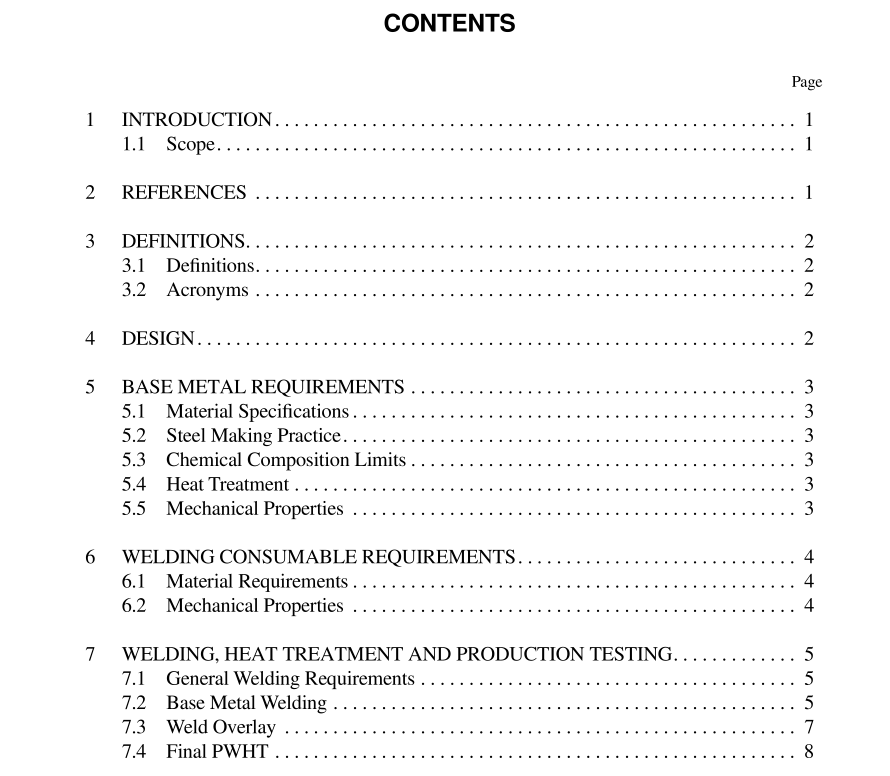API RP 934 pdf download

API RP 934 pdf download.Materials and Fabrication Requirements for 2- 1 / 4 CR-1MO & 3CR-1MO Steel Heavy Wall Pressure Vessels For High Temp., High Pressure Hydrogen Service
1 Introduction
This recommended practice applies to new heavy wall pressure vessels in petroleum refining, petrochemical and chemical facilities in which hydrogen or hydrogen-containing fluids are processed at elevated temperature and pressure. It is based on decades of industry operating experience and the results of experimentation and testing conducted by indepen- dent manufacturers, fabricators and users of heavy wall pres- sure vessels for this service. Licensors and owners of process units in which these heavy wall pressure vessels are to be used may modify and/or supplement this recommended practice with additional pro- prietary requirements. 1.1 SCOPE This recommended practice presents materials and fabrica- tion requirements for new 2– 1 / 4 Cr and 3Cr steel heavy wall pressure vessels for high temperature, high pressure hydrogen service. It applies to vessels that are designed, fabricated, cer- tified and documented in accordance with ASME Code Sec- tion VIII, Division 2, including Appendix 26, Mandatory Rules for Cr-Mo Steels with Additional Requirements for Welding and Heat Treatment and ASME Code Case 2151, as applicable. Materials covered by this recommended practice are conventional steels including standard 2– 1 / 4 Cr–1Mo and standard 3Cr–1Mo steels, and advanced steels including enhanced 2– 1 / 4 Cr–1Mo, 2– 1 / 4 Cr–1Mo– 1 / 4 V, 3Cr–1Mo– 1 / 4 V–Ti–B, and 3Cr–1Mo– 1 / 4 V–Cb–Ca steels. The inte- rior surfaces of these heavy wall pressure vessels may have an austenitic stainless steel weld overlay to provide additional corrosion resistance.
4 Design
4.1 Design and manufacture shall conform to the ASME Boiler and Pressure Vessel Code , Section VIII, Division 2. The latest edition including addenda effective through the date of the purchase agreement shall be used. 4.2 Design issues are typically covered by a manufacturer’s design report that shows compliance of the design with the user’s design document, ASME Code strength calculations, drawings and local stress analysis for extra loads, and special design requirements, if required. 4.3 This recommended practice is not intended to cover design issues other than those below. 4.3.1 Weld seam layouts shall provide that all welds are accessible for fabrication and in-service NDE such as RT, UT, MT, and PT. 4.3.2 Nozzle necks shall have transition to the vessel body as shown in Figure AD-560.1 and Figure AD-613.1 of the ASME Code.
5 Base Metal Requirements
5.1 MATERIAL SPECIFICATIONS 5.1.1 Base metals shall be in accordance with the applica- ble ASME specifications indicated in Table 4–1. 5.1.2 Unless approved in advance by the owner/user, dif- ferent base metals shall not be mixed in the same vessel (e.g., 2– 1 / 4 Cr–1 Mo– 1 / 4 V nozzles shall not be used with standard 2– 1 / 4 Cr–1 Mo shell plates). 5.2 STEEL MAKING PRACTICE 5.2.1 In addition to steel making practices outlined in the applicable material specifications, the steels shall be vacuum degassed. 5.3 CHEMICAL COMPOSITION LIMITS Chemical composition of the base metals shall be limited as follows in order to minimize susceptibility to temper embrittlement (these chemical composition limits apply to each heat analysis): J-factor = (Si + Mn) x (P + Sn) x 10 4 £ 100 [Si, Mn, P, and Sn in wt%] Cu content: 0.20% maximum Ni content: 0.30% maximum 5.4 HEAT TREATMENT 5.4.1 All product forms shall be normalized and tempered or quenched and tempered to meet the required mechanical properties. Cooling from the austenitizing temperature shall be accelerated by air blasting or liquid quenching to develop a microstructure consisting of a minimum of 90% bainite.









